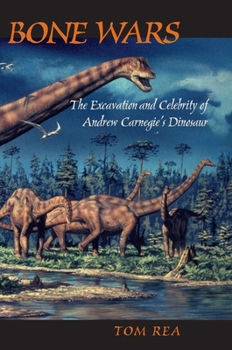Bone Wars: The Excavation and Celebrity of Andrew Carnegie's Dinosaur
Select Format
Select Condition 
Book Overview
Winner of the 2002 Spur Award for Best Western Nonfiction - Contemporary Less than one hundred years ago, Diplodocus carnegii--named after industrialist and philanthropist Andrew Carnegie--was the most famous dinosaur on the planet. The most complete fossil skeleton unearthed to date, and one of the largest dinosaurs ever discovered, Diplodocus was displayed in a dozen museums around the world and viewed by millions of people. Bone Wars explains how...
Format:Paperback
Language:English
ISBN:0822958465
ISBN13:9780822958468
Release Date:May 2004
Publisher:University of Pittsburgh Press
Length:276 Pages
Weight:1.02 lbs.
Dimensions:0.8" x 5.7" x 8.9"
Customer Reviews
2 ratings
An extensive bibliography and index enhance this truly enjoyable and informative history
Published by Thriftbooks.com User , 19 years ago
Knowledgeably written by former journalist Tom Rea, Bone Wars: The Excavation And Celebrity Of Andrew Carnegie's Dinosaurs is the award- winning true story of how a Diplodicus carngeii fossil (named after famous industrialist and philanthropist Andrew Carnegie) found in the Wyoming badlands helped bring about public fascination with the great beasts of millennia past. Though Bone Wars is entirely nonfiction, it is so deftly written that it reads like a novel as it follows the battles of individuals, conflicting scientific theories, and even instances of backstabbing and double-crossing in the bone-hunting world of a century past. An extensive bibliography and index enhance this truly enjoyable and informative history, which is especially recommended for dinosaur and paleontology enthusiasts.
Bruce Millers Review
Published by Thriftbooks.com User , 23 years ago
Where Dead Voices GatherNick Tosches Little Brown and Company writer: BRUCE MILLER With his big bushy moustache and sun-weathered skin,Tom Rea looks like one of the tough paleontologists staringout of one of the black-and-white photographs in his book,Bone Wars: The Excavation and Celebrity of Andrew Carnegie'sDinosaur. His voice, though, has the soft polite tone of aprofessional who has worked indoors for the better part of hislife. Imagining Rea to be like one of the men he wrote about isprobably a tribute to how vividly he portrays the people whomade Carnegie's dinosaur such a sensation. Rea is quick tocite the abundance of letters he used as primary source material. "The whole story is filled with interesting characters," says Rea."The personalities are so strong in those letters. I don't know ifit's the line of work that draws strong-minded people to it --they certainly weren't in it for the money -- but in any case theydidn't want other people to get in the way of finding out whatthe bones could tell them. Sometimes they disagreed quite strongly." Rea comes from a family that knows geology and paleontology -- his uncle is a geologist; his brother is a geologist at theUniversity of Michigan; geology was also his mother's avocation-- but he came to write his book by following a less scientificpath. He grew up in Pittsburgh looking at Carnegie's dinosaurat the Carnegie Museum. After graduating from WilliamsCollege in Massachusetts in the early 1970s, Rea spent a fewsummers visiting his uncle's ranch. He became a reporter forthe Wyoming's Casper Star-Tribune for the next 13 years,though he maintained an amateur interest in geology andpaleontology. In 1990, he started working on an article for the paper about, how Carnegie's famous dinosaur made its way from Wyoming to Pittsburgh. During his research, he became fascinated with the fossil digs and disputes that surrounded the unearthing of the bones. When he quit the paper in 1998, he wanted to write a book about a number of these controversies, but an editor suggested he focus on just one. Then, in 1999, he came to the Carnegie Museum. "Not until I got here did I realize how many letters they were,"says Rea. "They had archives there that yielded all theresources to write the book I wanted to write." Correspondence between Carnegie and then-museum directorWilliam Holland, who Rea says figures as "the Darth Vader ofthe story," was right next door at the Carnegie Library. Reaended up using the archives of a number of Pittsburgh groups. "[Holland's] secretary typed and saved every letter, even putthem in chronological order, so it was very easy to follow," Rea says. The first person who caught Rea's attention was Bill Reed, thetough, autodidactic Wyomingite who found Carnegie's dinosaur."He was a frontiersman who was dealing with people from theEast who didn't particularly respect him because he was aWesterner," Rea says. "It was a different time back then. A guylike Reed who'd been a buffalo hunter





